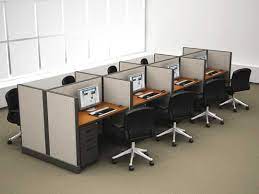What Are The Disadvantages Of Cubicle?
Cubicles for office space due to their ability to maximize the use of space and provide some level of privacy for employees. However, there are also several disadvantages to using cubicles.
One major disadvantage is that they can create a feeling of isolation and hinder communication among employees. Cubicles may also not provide adequate sound insulation, which can lead to distractions and reduced productivity. Additionally, cubicles may not provide enough natural light, which can impact employee well-being and productivity.
Furthermore, cubicles may not provide enough storage space for employees, leading to clutter and disorganization. They may also contribute to a lack of personalization and creativity in the workplace. Finally, cubicles may not be suitable for all types of work, such as jobs that require a high degree of collaboration or confidentiality.
Cubicles call center can have several disadvantages for employees. Firstly, they can create a feeling of isolation and lack of privacy, leading to a negative impact on employee morale and job satisfaction. Cubicles can also limit communication and collaboration between employees, which can be detrimental to teamwork and productivity. Additionally, cubicles can be noisy and distracting, making it difficult for employees to concentrate on their work and handle customer calls effectively. They can also be uncomfortable and cause health problems such as eye strain, back pain, and repetitive stress injuries. Lastly, cubicles can create a monotonous and dull work environment, leading to burnout and high turnover rates.
Cubicles are an efficient way to maximize office space while still providing employees with a semi-private workspace. Cubicles became popular in the 1960s, and their design has remained relatively unchanged since then. Cubicles have several advantages, such as lower costs, flexibility, and privacy. However, they also have significant drawbacks that can impact employee productivity, satisfaction, and health. This essay will discuss the disadvantages of cubicles and explore how they affect employees and companies.
Lack Of Privacy
One of the most significant disadvantages of cubicles is the lack of privacy they provide. While cubicles may offer more privacy than open office plans, they still do not provide enough for employees to focus on their work without distraction. The thin walls of cubicles do not block out noise, which can be a significant distraction for employees. Furthermore, employees can easily be interrupted by coworkers who need to ask a quick question or share a piece of information.
The lack of privacy can also lead to a sense of isolation for some employees. Employees may feel like they are working in a fishbowl, with their every move being watched by coworkers. This can lead to anxiety and a lack of trust in their colleagues. Additionally, the lack of privacy can make it difficult for employees to have confidential conversations, which can be problematic for companies dealing with sensitive information.
Lack Of Natural Light
Another disadvantage of cubicles is the lack of natural light. Many cubicles are located in the center of the office space, far from windows and natural light sources. This can lead to a lack of exposure to natural light, which can have a negative impact on employees’ health and well-being.
Studies have shown that exposure to natural light can improve mood, increase productivity, and reduce stress. Without access to natural light, employees may experience headaches, eye strain, and fatigue. Furthermore, the lack of natural light can disrupt circadian rhythms, leading to sleep problems and an increased risk of depression.
Limited Space
Cubicles are designed to maximize office space, which means they often offer limited space for employees. This can make it difficult for employees to organize their workspace, leading to clutter and disorganization. Additionally, the limited space can make it difficult for employees to move around, leading to a sedentary lifestyle and associated health problems.
Furthermore, the limited space can impact the quality of work employees produce. If employees feel cramped and uncomfortable in their workspace, they may rush through their work or make mistakes. Additionally, the limited space can make it difficult for employees to collaborate with coworkers, leading to a lack of innovation and creativity.
Negative Impact On Communication
Cubicles can also have a negative impact on communication within the workplace. The walls of cubicles can make it difficult for employees to communicate with each other, leading to a lack of collaboration and teamwork. This can be particularly problematic for companies that rely on teamwork to complete projects and meet deadlines.
The lack of communication can also lead to a lack of socialization within the workplace. Employees may feel isolated and disconnected from their colleagues, which can impact their job satisfaction and morale. Additionally, the lack of communication can make it difficult for managers to provide feedback and guidance to employees, leading to a lack of professional development.
Conclusion
In conclusion, cubicles have several significant disadvantages that can impact employees and companies. The lack of privacy, natural light, and space can lead to health problems, decreased productivity, and a lack of innovation. Additionally, the walls of cubicles can have a negative impact on communication and teamwork within the workplace. While cubicles may be an efficient way to maximize office space, companies must consider the negative impact they can have on their employees’ well-being and job satisfaction. Companies should explore alternative workspace options, such as open office plans or remote work, to



